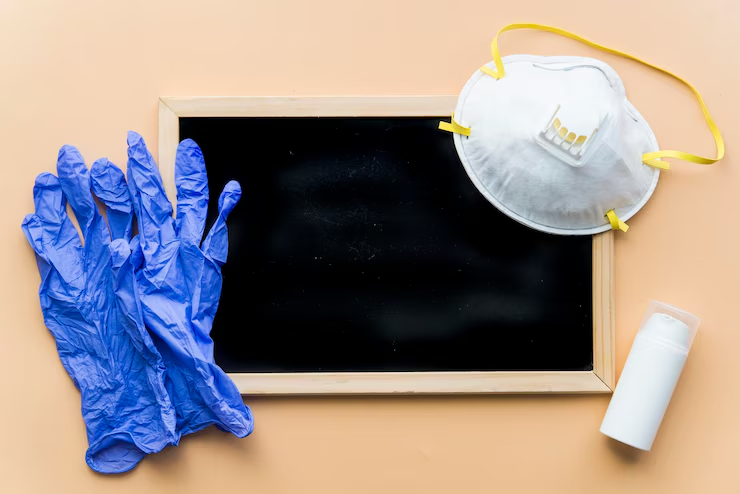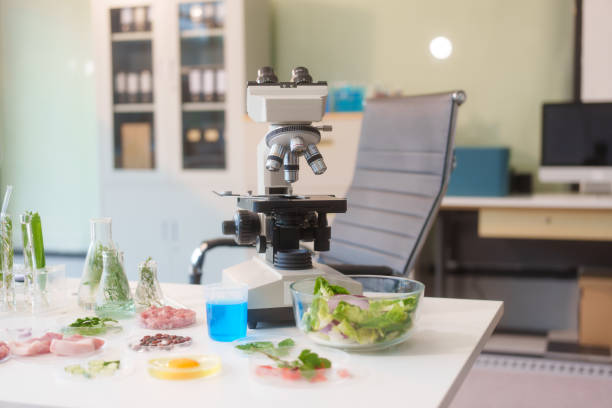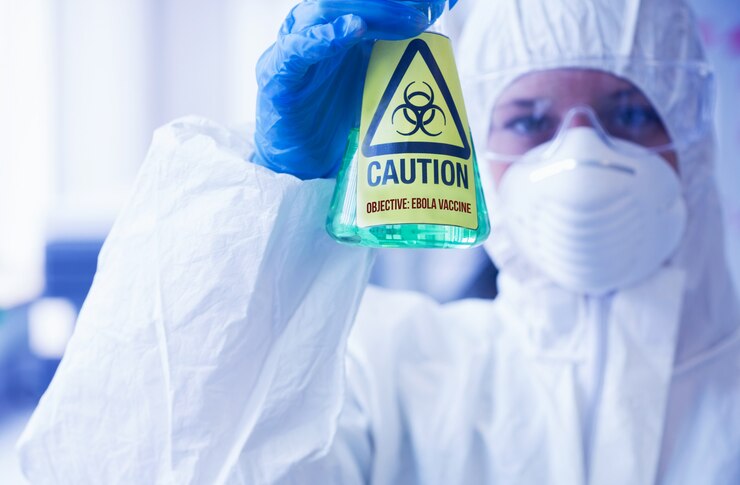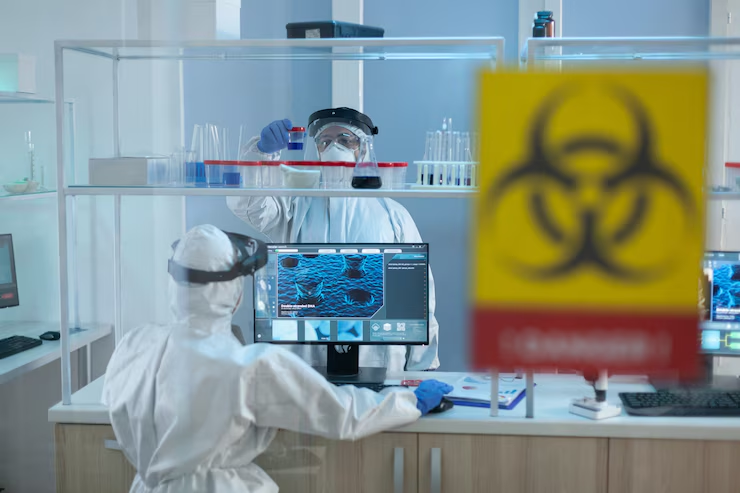Laboratories play a central role in scientific discovery, but they also present a range of potential hazards. Whether you’re a student, a professional chemist, or a lab technician, adhering to proper lab safety protocols is essential for both your safety and the success of your experiments. In this detailed guide, we explore key science laboratory safety rules to help you navigate lab environments with confidence and responsibility.
Laboratory Safety is Important
Safety in the laboratory goes beyond wearing a lab coat and goggles. It involves a systematic approach to identifying, understanding, and minimizing potential risks. Accidents in laboratories can lead to severe injuries, chemical burns, fire hazards, or contamination. Adhering to well-established safety rules not only protects individuals but also safeguards equipment, experiments, and the environment.
General Laboratory Safety Rules

1. Always Ensure You’re Wearing the Proper Personal Protective Gear (PPE)
- A lab coat to protect against spills.
- Wear safety goggles to protect your eyes from harmful splashes or chemical fumes.
- Gloves to prevent direct contact with chemicals or biological specimens.
- Closed-toe shoes and long pants are recommended to avoid exposure to harmful substances.
2. Know the Location of Safety Equipment
Familiarize yourself with:
- Fire extinguishers
- Safety showers
- Eyewash stations
- First aid kits
- Emergency exits
This knowledge is vital in case of emergencies.
3. Do Not Eat, Drink, or Apply Cosmetics in the Lab
Food, beverages, and cosmetics can be contaminated by hazardous substances. Keep all personal items outside the laboratory to prevent accidental ingestion or contamination.
4. Label and Store Chemicals Properly
Ensure all containers are clearly labeled with:
- Chemical name
- Concentration
- Hazard symbols
- Date of preparation
Store incompatible chemicals separately and according to recommended temperature and ventilation guidelines.
Chemical Handling and Disposal Safety
5. Read and Understand MSDS
Before using any chemical, consult its Material Safety Data Sheet (MSDS) or Safety Data Sheet (SDS) for information on:
- Hazards
- Handling procedures
- Storage requirements
- Disposal methods
- First aid measures
6. Never Mix Chemicals Without Proper Knowledge
Randomly mixing chemicals can cause dangerous reactions such as explosions, toxic gas releases, or fires. Always follow experimental protocols strictly.
7. Dispose of Waste Correctly
- Separate chemical, biological, and sharp waste.
- Use designated containers for each type.
- Never pour chemicals down the drain unless permitted by safety guidelines.
Equipment Safety Rules

8. Inspect Equipment Before Use
Check all equipment, such as Bunsen burners, hot plates, and glassware, for damage or malfunction before starting your experiment.
9. Use Fume Hoods When Required
Conduct procedures that involve volatile chemicals or harmful vapors under a fume hood to protect yourself from inhaling hazardous substances.
10. Turn Off Equipment After Use
Always shut down equipment like heaters, centrifuges, and gas supplies when not in use. This prevents fire hazards and conserves energy.
Personal Behavior in the Laboratory
11. Avoid Horseplay
Labs are not places for pranks or running around. Stay focused and serious to prevent accidents.
12. Tie Back Long Hair and Secure Loose Clothing
Loose items can catch fire or get entangled in equipment. Always dress appropriately and maintain a neat appearance.
13. Keep Your Workspace Clean
Keeping your workspace clean helps prevent accidents and contamination. Clean up spills right away and always put equipment back where it belongs.
Emergency Response Rules
14. Report All Accidents Immediately
Whether it’s a minor cut, a chemical spill, or broken glass, report it to your supervisor or instructor without delay.
15. Know the Evacuation Plan
Be aware of your lab’s emergency evacuation procedures in case of fire, chemical leaks, or other emergencies. Participate in regular drills.
16. Apply First Aid When Necessary
For minor injuries, use the lab’s first aid kit. For serious accidents, seek medical attention and notify emergency services immediately.
Electrical and Fire Safety
17. Handle Electrical Equipment with Caution
Avoid using damaged cords or equipment. Keep water away from electrical setups, and unplug devices when not in use.
18. Know How to Use a Fire Extinguisher
Remember the PASS technique:
- Pull the pin
- Aim at the base of the fire
- Squeeze the handle
- Sweep side to side
Biological Safety Rules
19. Treat All Biological Specimens as Potential Hazards

Use proper containment procedures and biosafety cabinets when handling biological materials.
20. Sterilize Equipment After Use
Sterilize reusable instruments and dispose of biological waste in autoclave-safe containers or according to biosafety regulations.
Digital Lab Safety and Data Management
21. Backup Experimental Data Regularly
Keep digital records of your research on secure cloud or external drives to avoid data loss due to accidents.
22. Avoid Unauthorized Software or Equipment
Only use approved software and calibrated instruments for accurate and secure experimentation.
23. Conduct Risk Assessments Before Starting Experiments
Always conduct a risk assessment before starting any new procedure to spot potential hazards and decide on the most effective safety measures. This should involve reviewing:
- The chemicals and reagents involved
- Equipment to be used
- Environmental conditions (e.g., ventilation, temperature)
- Emergency protocols
Being proactive helps prevent accidents and ensures preparedness.
24. Stay Updated with Safety Training
Lab safety standards are continuously evolving. Regularly participate in safety workshops, drills, and training sessions to stay informed about the latest procedures and technologies in lab safety.
25. Never Work Alone in the Laboratory
Always ensure that at least one other person is present while conducting experiments, especially when working with hazardous materials. In case of an accident, immediate assistance can be crucial.
26. Record Observations and Incidents
Maintain a laboratory notebook or logbook where you document all procedures, observations, and any safety incidents. This record can help identify recurring issues and improve lab practices over time.
Safety Culture in Laboratories
Creating a safety-focused culture is key to long-term success in any lab setting. Promote open communication so team members feel confident reporting unsafe practices or offering suggestions for improvement. Acknowledge and reward those who follow safety guidelines to encourage positive habits.
Promoting a Safety Culture Includes:
- Setting a good example as a leader or instructor
- Holding regular safety meetings
- Conducting periodic audits and safety reviews
- Encouraging peer-to-peer accountability
Common Laboratory Hazards to Watch Out For
- Chemical Spills and Reactions
Can cause fires, explosions, or toxic exposure. - Biological Contamination
Risk of infection or environmental harm if not handled properly. - Electrical Hazards
Faulty wiring or equipment can lead to shocks or fires. - Glassware Breakage
Broken glass can cause severe cuts or contamination. - Inhalation of Fumes or Gases
It can lead to respiratory issues or poisoning.
Being vigilant and proactive helps minimize these risks significantly.
Lab Safety for Students and Beginners
If you’re new to the lab environment, here are a few extra tips:
- If you’re ever uncertain about a procedure, don’t hesitate to ask questions.
- Follow your supervisor’s instructions closely.
- Double-check measurements and labels before mixing any substances.
- Start with simple experiments to build confidence before moving to advanced tasks.
Conclusion
Adhering to laboratory safety rules is not optional; it is a fundamental responsibility of anyone working in a lab setting. Safety consciousness ensures not only your protection but also the accuracy, credibility, and efficiency of your scientific work. Whether you’re a beginner or a seasoned researcher, following these guidelines can make the difference between a successful experiment and a dangerous incident.
Creating a safe laboratory environment is a shared responsibility. By understanding and implementing these laboratory safety rules, we not only protect ourselves but also maintain the integrity of scientific research. Whether you’re in a school lab, a university setting, or a professional research facility, a culture of safety is essential for productivity and progress.
What are the laboratory safety rules?
Laboratory Safety is Important
Safety in the laboratory goes beyond wearing a lab coat and goggles. It involves a systematic approach to identifying, understanding, and minimizing potential risks. Accidents in laboratories can lead to severe injuries, chemical burns, fire hazards, or contamination. Adhering to well-established safety rules not only protects individuals but also safeguards equipment, experiments, and the environment.
General Laboratory Safety Rules

1. Always Ensure You’re Wearing the Proper Personal Protective Gear (PPE)
A lab coat to protect against spills.
Wear safety goggles to protect your eyes from harmful splashes or chemical fumes.
Gloves to prevent direct contact with chemicals or biological specimens.
Closed-toe shoes and long pants are recommended to avoid exposure to harmful substances.
2. Know the Location of Safety Equipment
Familiarize yourself with:
Fire extinguishers
Safety showers
Eyewash stations
First aid kits
Emergency exits
This knowledge is vital in case of emergencies.
3. Do Not Eat, Drink, or Apply Cosmetics in the Lab
Food, beverages, and cosmetics can be contaminated by hazardous substances. Keep all personal items outside the laboratory to prevent accidental ingestion or contamination.
4. Label and Store Chemicals Properly
Ensure all containers are clearly labeled with:
Chemical name
Concentration
Hazard symbols
Date of preparation
Store incompatible chemicals separately and according to recommended temperature and ventilation guidelines.
Chemical Handling and Disposal Safety
5. Read and Understand MSDS
Before using any chemical, consult its Material Safety Data Sheet (MSDS) or Safety Data Sheet (SDS) for information on:
Hazards
Handling procedures
Storage requirements
Disposal methods
First aid measures
6. Never Mix Chemicals Without Proper Knowledge
Randomly mixing chemicals can cause dangerous reactions such as explosions, toxic gas releases, or fires. Always follow experimental protocols strictly.
7. Dispose of Waste Correctly
Separate chemical, biological, and sharp waste.
Use designated containers for each type.
Never pour chemicals down the drain unless permitted by safety guidelines.
Equipment Safety Rules
 A food scientist analyzes food samples, plants, vegetables, and meat using a microscope and laboratory equipment to ensure safety, quality, and innovation in food science and technology
A food scientist analyzes food samples, plants, vegetables, and meat using a microscope and laboratory equipment to ensure safety, quality, and innovation in food science and technology8. Inspect Equipment Before Use
Check all equipment, such as Bunsen burners, hot plates, and glassware, for damage or malfunction before starting your experiment.
9. Use Fume Hoods When Required
Conduct procedures that involve volatile chemicals or harmful vapors under a fume hood to protect yourself from inhaling hazardous substances.
10. Turn Off Equipment After Use
Always shut down equipment like heaters, centrifuges, and gas supplies when not in use. This prevents fire hazards and conserves energy.
Personal Behavior in the Laboratory
11. Avoid Horseplay
Labs are not places for pranks or running around. Stay focused and serious to prevent accidents.
12. Tie Back Long Hair and Secure Loose Clothing
Loose items can catch fire or get entangled in equipment. Always dress appropriately and maintain a neat appearance.
13. Keep Your Workspace Clean
Keeping your workspace clean helps prevent accidents and contamination. Clean up spills right away and always put equipment back where it belongs.
Emergency Response Rules
14. Report All Accidents Immediately
Whether it’s a minor cut, a chemical spill, or broken glass, report it to your supervisor or instructor without delay.
15. Know the Evacuation Plan
Be aware of your lab’s emergency evacuation procedures in case of fire, chemical leaks, or other emergencies. Participate in regular drills.
16. Apply First Aid When Necessary
For minor injuries, use the lab’s first aid kit. For serious accidents, seek medical attention and notify emergency services immediately.
Electrical and Fire Safety
17. Handle Electrical Equipment with Caution
Avoid using damaged cords or equipment. Keep water away from electrical setups, and unplug devices when not in use.
18. Know How to Use a Fire Extinguisher
Remember the PASS technique:
Pull the pin
Aim at the base of the fire
Squeeze the handle
Sweep side to side
Biological Safety Rules
19. Treat All Biological Specimens as Potential Hazards

Use proper containment procedures and biosafety cabinets when handling biological materials.
20. Sterilize Equipment After Use
Sterilize reusable instruments and dispose of biological waste in autoclave-safe containers or according to biosafety regulations.
Digital Lab Safety and Data Management
21. Backup Experimental Data Regularly
Keep digital records of your research on secure cloud or external drives to avoid data loss due to accidents.
22. Avoid Unauthorized Software or Equipment
Only use approved software and calibrated instruments for accurate and secure experimentation.
23. Conduct Risk Assessments Before Starting Experiments
Always conduct a risk assessment before starting any new procedure to spot potential hazards and decide on the most effective safety measures. This should involve reviewing:
The chemicals and reagents involved
Equipment to be used
Environmental conditions (e.g., ventilation, temperature)
Emergency protocols
Being proactive helps prevent accidents and ensures preparedness.
24. Stay Updated with Safety Training
Lab safety standards are continuously evolving. Regularly participate in safety workshops, drills, and training sessions to stay informed about the latest procedures and technologies in lab safety.
25. Never Work Alone in the Laboratory
Always ensure that at least one other person is present while conducting experiments, especially when working with hazardous materials. In case of an accident, immediate assistance can be crucial.
26. Record Observations and Incidents
Maintain a laboratory notebook or logbook where you document all procedures, observations, and any safety incidents. This record can help identify recurring issues and improve lab practices over time.
Safety Culture in Laboratories
Creating a safety-focused culture is key to long-term success in any lab setting. Promote open communication so team members feel confident reporting unsafe practices or offering suggestions for improvement. Acknowledge and reward those who follow safety guidelines to encourage positive habits.
Promoting a Safety Culture Includes:
Setting a good example as a leader or instructor
Holding regular safety meetings
Conducting periodic audits and safety reviews
Encouraging peer-to-peer accountability
Common Laboratory Hazards to Watch Out For
Chemical Spills and Reactions
Can cause fires, explosions, or toxic exposure.
Biological Contamination
Risk of infection or environmental harm if not handled properly.
Electrical Hazards
Faulty wiring or equipment can lead to shocks or fires.
Glassware Breakage
Broken glass can cause severe cuts or contamination.
Inhalation of Fumes or Gases
It can lead to respiratory issues or poisoning.
Being vigilant and proactive helps minimize these risks significantly.
Lab Safety for Students and Beginners
If you’re new to the lab environment, here are a few extra tips:
If you’re ever uncertain about a procedure, don’t hesitate to ask questions.
Follow your supervisor’s instructions closely.
Double-check measurements and labels before mixing any substances.
Start with simple experiments to build confidence before moving to advanced tasks.
Conclusion
Adhering to laboratory safety rules is not optional—it is a fundamental responsibility of anyone working in a lab setting. Safety consciousness ensures not only your protection but also the accuracy, credibility, and efficiency of your scientific work. Whether you’re a beginner or a seasoned researcher, following these guidelines can make the difference between a successful experiment and a dangerous incident.
Creating a safe laboratory environment is a shared responsibility. By understanding and implementing these laboratory safety rules, we not only protect ourselves but also maintain the integrity of scientific research. Whether you’re in a school lab, a university setting, or a professional research facility, a culture of safety is essential for productivity and progress.
What should we do if there is a fire in the lab?
Explain the laboratory safety rules.
Laboratory Safety is Important: Laboratory Safety Rules
Safety in the laboratory goes beyond wearing a lab coat and goggles. It involves a systematic approach to identifying, understanding, and minimizing potential risks. Accidents in laboratories can lead to severe injuries, chemical burns, fire hazards, or contamination. Adhering to well-established safety rules not only protects individuals but also safeguards equipment, experiments, and the environment.
General Laboratory Safety Rules

1. Always Ensure You’re Wearing the Proper Personal Protective Gear (PPE)
A lab coat to protect against spills.
Wear safety goggles to protect your eyes from harmful splashes or chemical fumes.
Gloves to prevent direct contact with chemicals or biological specimens.
Closed-toe shoes and long pants are recommended to avoid exposure to harmful substances.
2. Know the Location of Safety Equipment: Laboratory Safety Rules
Familiarize yourself with:
Fire extinguishers
Safety showers
Eyewash stations
First aid kits
Emergency exits
This knowledge is vital in case of emergencies.
3. Do Not Eat, Drink, or Apply Cosmetics in the Lab
Food, beverages, and cosmetics can be contaminated by hazardous substances. Keep all personal items outside the laboratory to prevent accidental ingestion or contamination.
4. Label and Store Chemicals Properly
Ensure all containers are clearly labeled with:
Chemical name
Concentration
Hazard symbols
Date of preparation
Store incompatible chemicals separately and according to recommended temperature and ventilation guidelines.
Chemical Handling and Disposal Safety
5. Read and Understand MSDS: Laboratory Safety Rules
Before using any chemical, consult its Material Safety Data Sheet (MSDS) or Safety Data Sheet (SDS) for information on:
Hazards
Handling procedures
Storage requirements
Disposal methods
First aid measures
6. Never Mix Chemicals Without Proper Knowledge: Laboratory Safety Rules
Randomly mixing chemicals can cause dangerous reactions such as explosions, toxic gas releases, or fires. Always follow experimental protocols strictly.
7. Dispose of Waste Correctly: Laboratory Safety Rules
Separate chemical, biological, and sharp waste.
Use designated containers for each type.
Never pour chemicals down the drain unless permitted by safety guidelines.
Equipment Safety Rules: Laboratory Safety Rules
 A food scientist analyzes food samples, plants, vegetables, and meat using a microscope and laboratory equipment to ensure safety, quality, and innovation in food science and technology
A food scientist analyzes food samples, plants, vegetables, and meat using a microscope and laboratory equipment to ensure safety, quality, and innovation in food science and technology8. Inspect Equipment Before Use: Laboratory Safety Rules
Check all equipment, such as Bunsen burners, hot plates, and glassware, for damage or malfunction before starting your experiment.
9. Use Fume Hoods When Required: Laboratory Safety Rules
Conduct procedures that involve volatile chemicals or harmful vapors under a fume hood to protect yourself from inhaling hazardous substances.
10. Turn Off Equipment After Use: Laboratory Safety Rules
Always shut down equipment like heaters, centrifuges, and gas supplies when not in use. This prevents fire hazards and conserves energy.
Personal Behavior in the Laboratory: Laboratory Safety Rules
11. Avoid Horseplay: Laboratory Safety Rules
Labs are not places for pranks or running around. Stay focused and serious to prevent accidents.
12. Tie Back Long Hair and Secure Loose Clothing: Laboratory Safety Rules
Loose items can catch fire or get entangled in equipment. Always dress appropriately and maintain a neat appearance.
13. Keep Your Workspace Clean: Laboratory Safety Rules
Keeping your workspace clean helps prevent accidents and contamination. Clean up spills right away and always put equipment back where it belongs.
Emergency Response Rules: Laboratory Safety Rules
14. Report All Accidents Immediately
Whether it’s a minor cut, a chemical spill, or broken glass, report it to your supervisor or instructor without delay.
15. Know the Evacuation Plan
Be aware of your lab’s emergency evacuation procedures in case of fire, chemical leaks, or other emergencies. Participate in regular drills.
16. Apply First Aid When Necessary: Laboratory Safety Rules
For minor injuries, use the lab’s first aid kit. For serious accidents, seek medical attention and notify emergency services immediately.
Electrical and Fire Safety
17. Handle Electrical Equipment with Caution: Laboratory Safety Rules
Avoid using damaged cords or equipment. Keep water away from electrical setups, and unplug devices when not in use.
18. Know How to Use a Fire Extinguisher: Laboratory Safety Rules
Remember the PASS technique:
Pull the pin
Aim at the base of the fire
Squeeze the handle
Sweep side to side
Biological Safety Rules
19. Treat All Biological Specimens as Potential Hazards: Laboratory Safety Rules

Use proper containment procedures and biosafety cabinets when handling biological materials.
20. Sterilize Equipment After Use: Laboratory Safety Rules
Sterilize reusable instruments and dispose of biological waste in autoclave-safe containers or according to biosafety regulations.
Digital Lab Safety and Data Management: Laboratory Safety Rules
21. Backup Experimental Data Regularly
Keep digital records of your research on secure cloud or external drives to avoid data loss due to accidents.
22. Avoid Unauthorized Software or Equipment
Only use approved software and calibrated instruments for accurate and secure experimentation.
23. Conduct Risk Assessments Before Starting Experiments
Always conduct a risk assessment before starting any new procedure to spot potential hazards and decide on the most effective safety measures. This should involve reviewing:
The chemicals and reagents involved
Equipment to be used
Environmental conditions (e.g., ventilation, temperature)
Emergency protocols
Being proactive helps prevent accidents and ensures preparedness.
24. Stay Updated with Safety Training: Laboratory Safety Rules
Lab safety standards are continuously evolving. Regularly participate in safety workshops, drills, and training sessions to stay informed about the latest procedures and technologies in lab safety.
25. Never Work Alone in the Laboratory
Always ensure that at least one other person is present while conducting experiments, especially when working with hazardous materials. In case of an accident, immediate assistance can be crucial.
26. Record Observations and Incidents
Maintain a laboratory notebook or logbook where you document all procedures, observations, and any safety incidents. This record can help identify recurring issues and improve lab practices over time.
Safety Culture in Laboratories: Laboratory Safety Rules
Creating a safety-focused culture is key to long-term success in any lab setting. Promote open communication so team members feel confident reporting unsafe practices or offering suggestions for improvement. Acknowledge and reward those who follow safety guidelines to encourage positive habits.
Promoting a Safety Culture Includes: Laboratory Safety Rules
Setting a good example as a leader or instructor
Holding regular safety meetings
Conducting periodic audits and safety reviews
Encouraging peer-to-peer accountability
Common Laboratory Hazards to Watch Out For
Chemical Spills and Reactions: Laboratory Safety Rules
Can cause fires, explosions, or toxic exposure.
Biological Contamination: Laboratory Safety Rules
Risk of infection or environmental harm if not handled properly.
Electrical Hazards: Laboratory Safety Rules
Faulty wiring or equipment can lead to shocks or fires.
Glassware Breakage: Laboratory Safety Rules
Broken glass can cause severe cuts or contamination.
Inhalation of Fumes or Gases: Laboratory Safety Rules
It can lead to respiratory issues or poisoning.
Being vigilant and proactive helps minimize these risks significantly.
Lab Safety for Students and Beginners: Laboratory Safety Rules
If you’re new to the lab environment, here are a few extra tips:
If you’re ever uncertain about a procedure, don’t hesitate to ask questions.
Follow your supervisor’s instructions closely.
Double-check measurements and labels before mixing any substances.
Start with simple experiments to build confidence before moving to advanced tasks.
Conclusion: Laboratory Safety Rules
Adhering to laboratory safety rules is not optional, it is a fundamental responsibility of anyone working in a lab setting. Safety consciousness ensures not only your protection but also the accuracy, credibility, and efficiency of your scientific work. Whether you’re a beginner or a seasoned researcher, following these guidelines can make the difference between a successful experiment and a dangerous incident.
Creating a safe laboratory environment is a shared responsibility. By understanding and implementing these laboratory safety rules, we not only protect ourselves but also maintain the integrity of scientific research. Whether you’re in a school lab, a university setting, or a professional research facility, a culture of safety is essential for productivity and progress.

12 thoughts on “Laboratory Safety Rules”